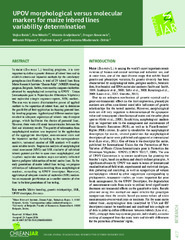Приказ основних података о документу
UPOV morphological versus molecular markers for maize inbred lines variability determination
| dc.creator | Babić, Vojka | |
| dc.creator | Nikolić, Ana | |
| dc.creator | Anđelković, Violeta | |
| dc.creator | Kovačević, Dragan | |
| dc.creator | Filipović, Milomir | |
| dc.creator | Mladenović Drinić, Snežana | |
| dc.creator | Vasić, Vladimir | |
| dc.date.accessioned | 2019-05-16T12:19:28Z | |
| dc.date.available | 2019-05-16T12:19:28Z | |
| dc.date.issued | 2016 | |
| dc.identifier.issn | 0718-5839 | |
| dc.identifier.uri | http://rik.mrizp.rs/handle/123456789/625 | |
| dc.description.abstract | In maize (Zen mays L.) breeding programs, it is very important to define a genetic distance of inbred lines and to establish criteria and biometric methods for the satisfactory germplasm classification. A total of 29 inbred lines from Maize Research Institute "Zemun Polje" (MRIZP) breeding program, Belgrade, Serbia, were used to compare similarities obtained by morphological (according to UPOV- Union Internationale pour la Protection des Obtentions Vegetales) and molecular (simple sequence repeats, SSR) markers. The aim was to assess discriminative power of applied markers in the separation of related lines, and to determine the possibility of their application in choosing parental lines for breeding programs. Application of different marker types resulted in adequate separation of inbreds into divergent groups, which facilitates the choice of parental lines. However, there were still many inconsistencies between the field and laboratory results. The quality of information from morphological markers was improved by the application of the appropriate descriptor, measurement scale and the biometric method. According to the correspondence analysis, increased number of SSR markers will enable more reliable results. Regression analysis of morphological visual assessment (MVG) and SSR similarity of individual inbreds pointed out that in some cases morphological, and in others molecular markers more accurately reflected known pedigree information of tested maize lines. In the early generations of maize inbred lines testing, we propose utilization of information resulting from in orphologi cal markers, according to UPOV descriptor. However, application of adequate number of molecular (SSR) markers has an economic justification on a smaller number of elite lines in the later generations of line testing. | en |
| dc.publisher | Inst Investigaciones Agropecuarias, Chillan | |
| dc.relation | info:eu-repo/grantAgreement/MESTD/Technological Development (TD or TR)/31068/RS// | |
| dc.rights | openAccess | |
| dc.source | Chilean Journal of Agricultural Research | |
| dc.subject | Maize breeding | en |
| dc.subject | genetic relationships | en |
| dc.subject | SSR | en |
| dc.subject | UPOV descriptor | en |
| dc.subject | Zea mays | en |
| dc.title | UPOV morphological versus molecular markers for maize inbred lines variability determination | en |
| dc.type | article | |
| dc.rights.license | ARR | |
| dc.citation.volume | 76 | |
| dc.citation.issue | 4 | |
| dc.citation.other | 76(4): - | |
| dc.citation.rank | M22 | |
| dc.identifier.wos | 000395392600004 | |
| dc.identifier.doi | 10.4067/S0718-58392016000400004 | |
| dc.identifier.scopus | 2-s2.0-85013498933 | |
| dc.identifier.fulltext | http://rik.mrizp.rs//bitstream/id/2565/623.pdf | |
| dc.type.version | publishedVersion |


